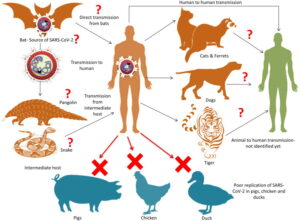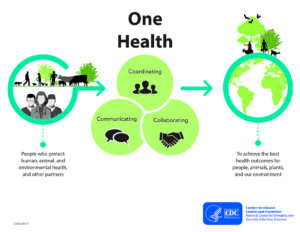Role of veterinarian and one health in fight against zoonosis
Dr Ruchi Singh Gaur
Veterinary Medical Officer Animal Husbandry Department U.P
Veterinarians care for animals health and work to protect public health.They diagnose, treat and research medical conditions and diseases of pets, livestock, and other animals.“Veterinarians directly prevent the spread of zoonotic disease by vaccinating companion animals against zoonotic diseases such as rabies, ensuring animal-based food is safe for human consumption, and educating the public on biosafety and biosecurity principles. In their role as advocates for animal health and welfare, veterinarians also have a responsibility to protect environmental health and demand action to minimize climate change.” Hence, Veterinarians are the key players in fight against zoonotic disease.
What is One Health?
One Health is an approach that recognizes that the health of people is closely connected to the health of animals and our shared environment. One health issues include zoonotic diseases, antimicrobial activity, food safety and food security, vector-borne diseases, environmental contamination, and other health threats shared by people, animals, and the environment. One health concept that was officially adopted by international organizations and scholarly bodies in 1984. It is the inclusive concept of combining human, animal, and environmental components to address global health challenges that have an ecological interconnectedness. One health is not new, but it has become more important in recent years. This is because many factors have changed interactions between people, animals, plants, and our environment. As the human populations are growing and expanding into new geographic areas they come more close and contact with wild and domestic animals, both livestock and pets. Although animals also play an important role in our lives, whether for food, fiber, livelihoods, travel, sport, education, or companionship. With the exception of above said, close contact with animals and their environments provides more opportunities for diseases to pass between animals and people. These changes led to the spread of existing or known (endemic) and new or emerging zoonotic diseases, which are diseases that can spread between animals and people. The earth has experienced changes in climate and land use, such as deforestation and intensive farming practices. Disruptions in environmental conditions and habitats can provide new opportunities for diseases to pass to animals. The movement of people, animals, and animal products has increased from international travel and trade. As a result, diseases can spread quickly across borders and around the globe.
Zoonosis
A zoonosis is any disease or infection that is naturally transmissible from vertebrate animals to humans. There are over 200 known types of zoonoses. Zoonoses comprise a large percentage of new and existing diseases in humans. Some zoonoses, such as rabies, are 100% preventable through vaccination and other methods. This type of disease passes from an animal or insect to a human. Zoonotic diseases range from minor short-term illness to a major life-changing illness. Certain ones can even cause death.
Types
The types of zoonosis include those caused by:
- a virus
- bacteria
- fungus
- parasites
Zoonotic diseases spread by mosquitos and ticks are some of the most serious of these diseases.
Examples of zoonotic diseases
Animal flu, anthrax, bird flu, bovine tuberculosis, brucellosis, Campylobacter infection, cat scratch fever, cryptosporidiosis, cysticercosis, dengue fever, Ebola, encephalitis from ticks, enzootic abortion, erysipeloid, giardiasis, glanders, hemorrhagic colitis, hepatitis E, hydatid disease, Leptospirosis, listeria infection, louping ill, Lyme disease, malaria, orf infection, pasteurellosis, plague, Q fever, rabies, rat-bite fever, ringworm, Rocky Mountain spotted fever, Salmonella and E. coli infections, streptococcal sepsis, swine flu, toxocariasis, toxoplasmosis, trichinellosis, tularemia.
Zoonoses can be transmitted in various ways:
- through the air
- by eating contaminated meat or produce
- through close contact with an infected animal
- by touching an area or surface that an infected animal touched
- through insect bites like mosquitos or ticks
Many transmissions occur when people hike, bike, boat, or enjoy other activities in the great outdoors.
Petting zoos are also common places for a zoonotic disease to be transmitted. Those who live and work on farms are in close contact with many types of livestock. Livestock is a common carrier of many zoonoses. Our family pet can carry ticks and fleas indoors that can then move onto you and your family. Animals also share our susceptibility to some diseases and environmental hazards. Because of this, they can sometimes serve as early warning signs of potential human illness. For example, birds often die of West Nile virus before people in the same area get sick with West Nile virus infection.

Fig.1. Human, animal, environmental health, and other relevant partners could be easily understand by above diagram.
One Health is gaining recognition in the United States and globally as an effective way to fight health issues at the human-animal-environment interface, including zoonotic diseases. CDC(centers for Disease control and prevention) uses a One Health approach by involving experts in human, animal, environmental health, and other relevant disciplines and sectors in monitoring and controlling public health threats and to learn about how diseases spread among people, animals, plants, and the environment.
Successful public health interventions require the cooperation of human, animal, and environmental health partners. Professionals in human health (doctors, nurses, public health practitioners, epidemiologists), animal health (veterinarians, paraprofessionals, agricultural workers), environment (ecologists, wildlife experts), and other areas of expertise need to communicate, collaborate on, and coordinate activities. Other relevant players in a One Health approach could include law enforcement, policymakers, agriculture, communities, and even pet owners. No one person, organization, or sector can address issues at the animal-human-environment interface alone.
By promoting collaboration across all sectors, a One Health approach can achieve the best health outcomes for people, animals, and plants in a shared environment.
Prevention and control
Prevention methods for zoonotic diseases differ for each pathogen; however, several practices are recognized as effective in reducing risk at the community and personal levels. Safe and appropriate guidelines for animal care in the agricultural sector help to reduce the potential for foodborne zoonotic disease outbreaks through foods such as meat, eggs, dairy or even some vegetables. Standards for clean drinking water and waste removal, as well as protections for surface water in the natural environment, are also important and effective. Education campaigns to promote handwashing after contact with animals and other behavioural adjustments can reduce community spread of zoonotic diseases when they occur.
Animals and zoonotic links of Corona virus
Corona virus causes respiratory infection including pneumonia, cold, sneezing and coughing while in animal it causes diarrhea and upper respiratory diseases. Corona virus transmitted human to human or human to animal via airborne droplets i.e a zoonotic disease Fig 2. Corona virus enters in human cell through membrane ACE-2 exopeptidase receptor. WHO and ECDC advised to avoid public place and close contact to infected persons and pet animals. Firstly Corona virus (2019-nCoV) was isolated from Wuhan market China at 7 Jan. 2020. The emergence of novel CoVs and their wide host range may be due to instability of the replicase enzyme, RNA dependent RNA polymerase, polybasic furin cleavage site, and O-linked glycans, lack of proofreading mechanism, a higher rate of mutations in gene and genetic recombination. This can be prevented by WHO general guidelines i.e by separating the infected patient from other family member to single room, implementation of contact and droplet precaution, airborne precaution etc. European Centre for Disease Prevention and Control (ECDC) also published the information leaflet to peoples i.e. Avoid contact with sick people, in particular those with a cough. Avoid visiting markets and places where live or dead animals are handled, Wash your hands with soap and water or use an alcohol based disinfectant solution before eating, after using the toilet and after any contact with animals, Avoid contact with animals, their excretions or droppings.

Fig.2. Transmission of Corona virus via human to human or human to animal or vice versa.
Conclusion
Zoonotic diseases are spreading from human to human transmission by close contact via airborne droplets generating by coughing, sneezing, kissing and handling of infected animals. So avoid these activities with infected partners, family members and pets. Corona virus may transmit through pet animals such as dog, cat, pig, cow, turkeys. So avoid contact and seprate them if observed any infection activities like diarrhea, cold, fever. As per WHO and CDC guideline avoid the contact with sick person and also avoid the market or public place as per possible.
https://www.cdc.gov/onehealth/basics/index.html


